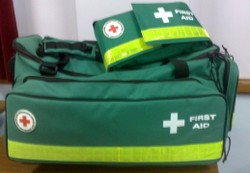We have an inbuilt urge to correct safety issues. We don't want to get hurt and we don't want people we love and connect with to get harmed.
Do we do what we do in the best way possible or do our emotions effect how we act and think?
Let's examine how our fear does effect our judgement and actions in trying to manage risk.

Safety Fears
by Fargy
We think we are rational, but we don't act like it. Safety is the control of risks, and we assess risk through emotional filters. We can't help it.
For the greater good.
In the US the Department of Homeland Security’s budget in 2011 was $47 billion.
The Occupational Health and Safety Administration had a budget of half a billion.
The Safety budget was 90 times lower.
Chance of workplace death was 270 times higher.
Our fears consume us and distract us.
Both of these organisations exist to keep us safe.
So why the imbalance in assigning resources to risks?
270 Americans die in a workplace accident for every 1 killed by a terrorist.
Yet there is no media outrage at all.
Until someone is killed by a terrorist.
Which shows that terrorists are doing the job of terror well. We have a quite natural urge to be safe. Which is why we spend so much, we are trying to comfort ourselves, rather than fix Safety.
For more reading...
How far is too far?
How safe is too safe?
We sometimes hear about parents of cotton wool kids, they stifle their child's development to keep them safe. Wrap them in cotton wool and bubble wrap. Keep them sanitized.
This is also apparent in how Governments can react.
The National Security Agency now has the permission, ability and will to copy all information that they can access. Which opens new risks. A thousand NSA employees have the ability to access this information, and once you spend money collecting this information it makes sense to use these resources. But how?
At any airport you can see the physical searches that are there to increase safety, at the loss of physical freedom. As if submitting to a random search in a jail.
Freedom revoked due to fear, in an attempt to be safe.
Can you be safe if you are afraid?
No.
That's the short answer.
You will never feel safe when afraid, you will act to try and remove that fear. Which is why we see the over-expenditure on trying to be safe from terrorism when hundreds more are dying in workplace accidents.
What can we do?
If you are feeling an emotion you don't want, like fear, you need to think differently or act differently.
There is a chain of fear here.
We have the terrorist using the media to gain the most bang for buck, the media feeds the fear and that directly effects elections, so government has to be seen to act. The government acts by removing freedoms and by waging huge budget war on fear. This war can include army mobilization and real war. Which results in others becoming unsafe, in more people dying, which terrorism can feed on for donations and recruits. And the cycle continues.
To become safer we need to change any one of these.
How we feel, how we act or how we think.
Libertas.
Libertas is the lady of Liberty that features in so many movies. Flame held aloft, broken chains at her feet. The constitution in her grasp.
And closed for three years after the 9/11 attacks, because of safety fears.
Part of her creed,
"Give me your tired, your poor,
Your huddled masses yearning to breathe free"
Would that be written today?
Are they lofty sentiments that find no reality when people feel fear?
Will our yearning for safety find a finish line?
Yes.
There was a time that we felt safer before. So that emotional state can return again.
How do we do this?
Two ways, open the conversation, start the information.
The media has to take part in this because terrorism uses them, without media there isn't much point to terrorism.
If you feel unsafe because of terrorism. You are being controlled. Take back control of your emotions, ask yourself why you are not enraged or worried about dying in the workplace, when that is the more likely event to occur.
We can be free again.
Other articles by this author...
You might also like
First Aid: Would you Know What to Do?A medical emergency could happen at any moment. The question is whether you h...
Piriformis - an unusual form of sciaticaOnly 10% of the population have their sciatic nerve pass through their pirifo...














 We are always wrongon 12/12/2014
We are always wrongon 12/12/2014
 Conspiracies are Realon 03/24/2014
Conspiracies are Realon 03/24/2014
 Workout for the Doleon 02/26/2014
Workout for the Doleon 02/26/2014
 Fiery New Brands for Aussie politicson 02/25/2014
Fiery New Brands for Aussie politicson 02/25/2014


Comments